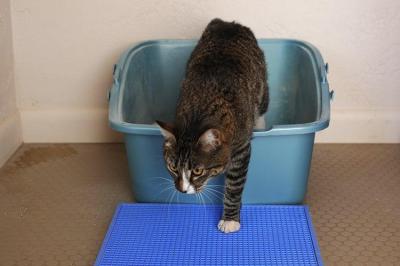
How to Get Your Cat to Use the Litter Box
Have you welcomed a new feline friend into your home and now are wondering how to get your cat to use the litter box? To start new cats off with good litter box habits and make their introduction to your home as smooth as possible, try to limit their stress. At first, it’s best to have them stay in a small room (e.g., a guest room, an office, or even a bathroom), so they can get their bearings and get used to the smells and sounds of their new environment.
A cat who is stressed might be less likely to display good litter box habits. Signs of stress in a cat include:
- Decreased appetite
- Hiding
- Decreased grooming
- Lack of interest in attention
- More quiet than normal
If the cat is hiding, don’t force them to come out; just let them venture out when they're ready. Be sure to equip the cat’s room with food, water, toys, scratching posts, and a litter box. You will also want to provide some cardboard boxes or something that the cat can hide in. Keep in mind that some cats are tree dwellers (they prefer high places to perch) and others are ground dwellers (they prefer low-to-the-ground places). Provide both high and low hiding places.
Home starts with you
Allow your new cat the time to get used to their new home on their terms. They'll let you know when they're ready to investigate the rest of the house. If the cat starts showing any of the signs of stress, bring them back to their small "safe room" to decompress.
Cat litter box training tips and tricks
You don’t need to show the cat where the litter box is. They will find it on their own and will most likely use it when you are not in the room, when it’s quiet, or when you’re sleeping.
Here are some tips and tricks to get your cat to use the litter box:
- Place the litter box as far as possible from the cat’s food and water but not in a high-traffic area.
- Cats prefer a quiet spot to go to the bathroom. However, don’t hide the litter box in a corner where the cat can't see someone coming. Cats can feel trapped if they don’t see an avenue of escape.
- The litter box should be large enough so the cat can comfortably turn around without touching the sides of the box.
- If you have a kitten, a cat with special needs, or a senior cat, make sure the cat can get in and out of the box with ease. You might need to get a box with low sides; another option is to roll up a towel and place it in front of the box, so the cat has a step to get inside.
- For kittens under 16 weeks old, it is safest to use non-clumping litter.
- Do not use litter box liners. Cats often get their claws stuck in the liner, tearing a hole in the liner, which causes issues with the cat’s use of the box and cleanup problems when removing the liner.
- Use an uncovered litter box, preferably containing unscented litter. Covered boxes trap the smell, making the odor much more intense for cats when they try to use the box. Also, cats’ sense of smell is many times stronger than ours, so even a bit of scent can be overpowering for them and cause litter box avoidance.
- If possible, use the same type of litter that the cat has been used to. If you are planning on changing to another kind of litter, add a box containing the litter you would like to start using and see whether the cat uses it. If they do, gradually add some of the new litter to the original box until you’ve completely replaced the old litter with the new.
- Fill the box with enough litter so the cat can dig and cover it up after eliminating. We recommend a depth of around 3 inches, adding more litter to the box daily after scooping.
- Scoop the box at least once a day. Cats prefer to go into a box that is clean and does not smell.
- At least every two weeks, completely dump the litter and clean the box using a mild soap. Cats don’t like harsh chemical smells, and plastic litter boxes will retain those harsh smells. Remember, cats’ noses are much more sensitive than ours are.
- In the rest of the house, place enough litter boxes for each cat plus one, plus one per level. For example, if you have four cats and you have a two-story house, you will need seven boxes (4+1+2). You want to make sure they can get to a litter box any time it’s needed.
- Keeping the boxes clean will eliminate many cat litter box problems down the road. We don’t enjoy stepping into a dirty bathroom, and neither do cats.
If your new cat does start eliminating outside the litter box, a trip to the vet is the first step toward correcting the behavior. A sick cat might stop using the box, especially in the case of a urinary tract or bladder infection. Once treated, the cat will usually return to their previous good habits, especially if you have provided them with a safe, comfortable litter box space.
By implementing these simple steps, you can help your new cat start off on the right foot with good litter box habits.
